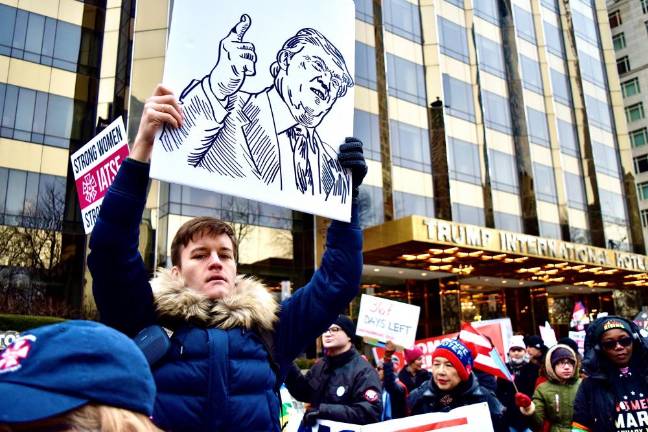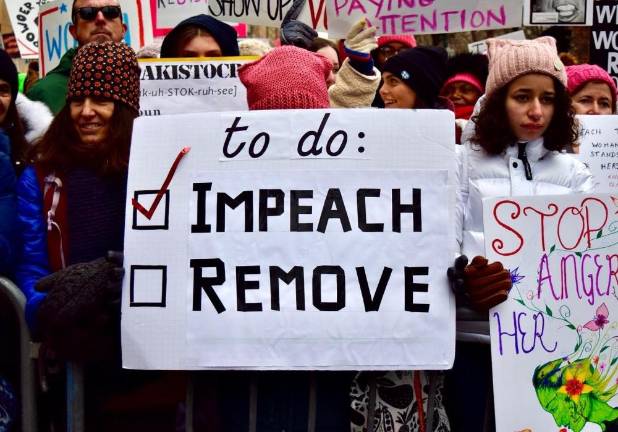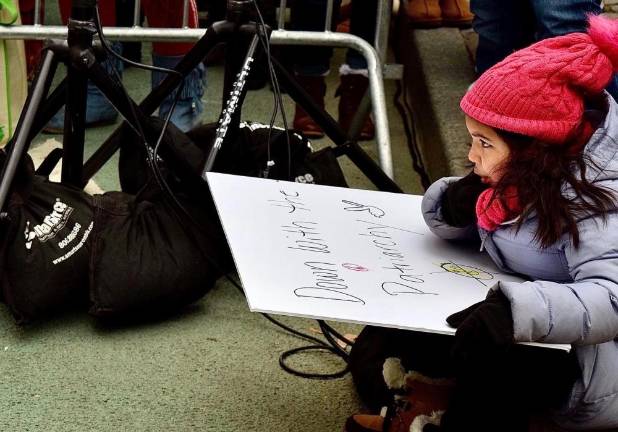After three years, they’re still marching.
Hundreds of protesters gathered for the fourth annual Women’s March in New York City Saturday morning, braving temperatures below 30 degrees and gusts of wind and snow.
The “Rise and Roar” rally kicked off at two separate locations — Foley Square and Columbus Circle — before the two groups marched and merged upon their arrival at Times Square later that afternoon.
In 2017, the march began as a rebuke of Donald Trump’s election to the presidency, and, while speakers did not invoke his name directly at the Columbus Circle rally, Trump was omnipresent. At the feet of the Trump International Hotel, speakers talked about the fight for pay equity, reproductive and equal rights, the #MeToo movement, and the importance of voting at every level.
Dianne Morales, a former CEO of a social services nonprofit who is running for mayor in 2021, spoke about the need for the movement to be intersectional and fight for women of color.
“The American dream has been more elusive for some of us than others. A significant portion of us are being left behind,” said Morales, who cited statistics claiming that African American women are two times more likely to be discriminated against in the workplace than white women and that the suicide rate for young Latina women is more than double that of non-Hispanic youth. “These facts can be discouraging. They can be daunting and they can be divisive, but it has been said that our most significant opportunity can be found in times of our greatest difficulties.”
She said it was time to recognize and reward women for the roles they’ve served as educators, healers and caretakers by putting them in positions of power.
“We need to disrupt the status quo and refuse to accept the norms of poverty and inequality,” said Morales. “We must build one movement for all of us.”
Heavy Coats and Pink Hats
Comptroller Scott Stringer offered brief remarks at the rally — saying he understood the importance of raising his two sons to respect women.
“When they become adult men, they have to respect and work for adult women,” said Stringer. “That is why today is so important. We have to do more to invest in women and minority owned businesses.”
The scale of Saturday’s march was smaller than in years past — and particularly its inaugural event, which attracted tens of thousands of people in the city and hundreds or thousands more around the world; but those who participated Saturday did not lack enthusiasm.
The crowd — mostly women of all ages — was bundled in heavy coats with many wearing what has become the march’s signature pink knitted hat. They were energized, engaging speakers and chanting back to them: “Today we rise! Today we roar!” They erupted when Senate Minority Leader Chuck Schumer emerged and joined the marchers, greeting them with handshakes as he made his way through the dense crowd.
The marchers held homemade signs ranging from straightforward and earnest (“Let America love again” and “Stop the war on women’s rights, vote them out”) to a bit more colorful (“No country for orange men” and “Keep your filthy laws off my silky drawers”). Some signs evoked powerful females icons of this era, including Greta Thunberg, Rep. Alexandria Ocasio-Cortez, Megan Rapinoe and House Speaker Nancy Pelosi.
Before the marchers made their way down Sixth Avenue and toward Times Square to meet their sister group, Manhattan Borough President Gale Brewer capped off the rally with passionate speech.
“Today, we are united. Tell that bully in Washington that we are united!” Brewer said, listing off the issues she will fight for, such as wages, anti-discrimination, reproductive health, housing, education and to support women running for office.
“We're gonna fight in 2020 for what's right,” said Brewer. “We're going to vote in 2020 and we're gonna vote those assholes out!”


